Google Organization Change Plan: Strategy, Behavior, and Motivation
VerifiedAdded on 2023/04/17
|19
|3328
|268
Report
AI Summary
This report presents an organization change plan, focusing on Google as a case study. It addresses the triggers for change, including technological advancements, managerial shifts, and competitive pressures, and explores how these factors necessitate strategic renewal. The plan delves into the behavioral aspects of organizational change, distinguishing between proactive and reactive approaches, and emphasizes the importance of motivating employees through both extrinsic and intrinsic means, such as bonuses, autonomy, and mastery. It also identifies potential sources of employee resistance, such as insecurity and economic losses, and highlights strategies to foster support by linking new systems with old ones and providing opportunities for skill development. The report concludes by examining trigger events that initiate change, such as crises, performance gaps, and new technologies, and emphasizes the need for organizations to adapt to market demands, increase revenue, diversify investments, and meet global standards. This document contributed by a student is available on Desklib, a platform offering a variety of study resources and AI-based tools for students.

Running head: Organization change plan
Organization change plan
Institution
Date
Organization change plan
Institution
Date
Paraphrase This Document
Need a fresh take? Get an instant paraphrase of this document with our AI Paraphraser
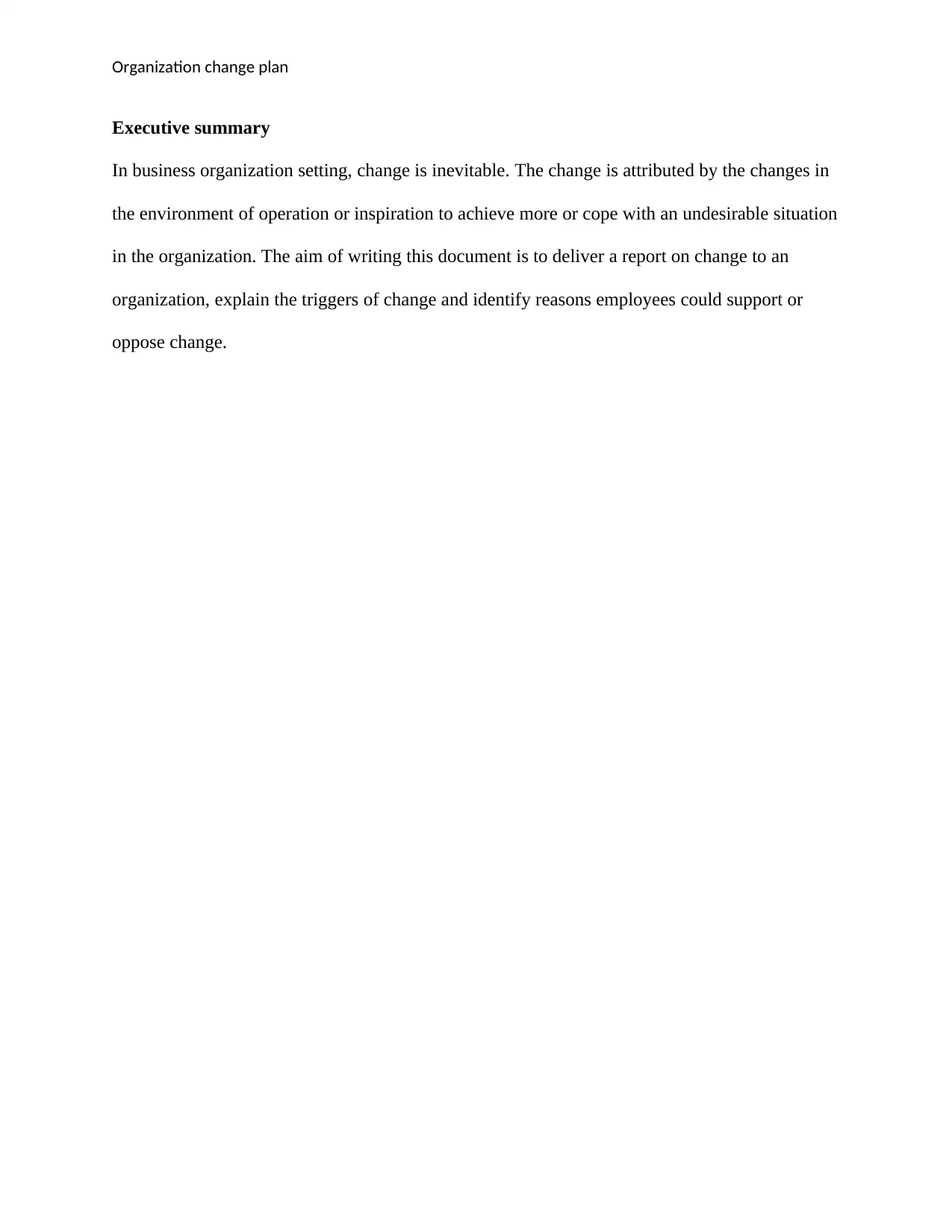
Organization change plan
Executive summary
In business organization setting, change is inevitable. The change is attributed by the changes in
the environment of operation or inspiration to achieve more or cope with an undesirable situation
in the organization. The aim of writing this document is to deliver a report on change to an
organization, explain the triggers of change and identify reasons employees could support or
oppose change.
Executive summary
In business organization setting, change is inevitable. The change is attributed by the changes in
the environment of operation or inspiration to achieve more or cope with an undesirable situation
in the organization. The aim of writing this document is to deliver a report on change to an
organization, explain the triggers of change and identify reasons employees could support or
oppose change.

Organization change plan
Table of Contents
Executive summary.....................................................................................................................................2
Introduction.................................................................................................................................................4
The portfolio................................................................................................................................................4
Reason I chosen Google..............................................................................................................................5
Objectives of the organization change plan.................................................................................................6
Role of the strategic renewal in propelling change......................................................................................7
The behavioral aspect of organizational change..........................................................................................8
Causes of organization's behavioral change.................................................................................................9
Dynamics of motivating employees to alter their behaviors......................................................................10
Instilling motivation..............................................................................................................................10
Developing psychological capital..........................................................................................................11
Building a supportive environment for change......................................................................................11
Faces of organizational change..................................................................................................................11
Turnaround............................................................................................................................................11
Tools and techniques.............................................................................................................................12
Transformation target............................................................................................................................12
Sources of employee's resistance to change...............................................................................................12
Insecurity...............................................................................................................................................12
Possible social loss................................................................................................................................12
Economic losses....................................................................................................................................13
Threat to influence.................................................................................................................................13
Sources of employees support to change...................................................................................................13
Expectation of benefiting.......................................................................................................................13
Linking the new and the old system......................................................................................................13
New skills..............................................................................................................................................13
Trigger events in initiating change in organization management...............................................................14
Crisis.....................................................................................................................................................14
Performance gap....................................................................................................................................14
New technology.....................................................................................................................................14
Identification of opportunity..................................................................................................................14
Table of Contents
Executive summary.....................................................................................................................................2
Introduction.................................................................................................................................................4
The portfolio................................................................................................................................................4
Reason I chosen Google..............................................................................................................................5
Objectives of the organization change plan.................................................................................................6
Role of the strategic renewal in propelling change......................................................................................7
The behavioral aspect of organizational change..........................................................................................8
Causes of organization's behavioral change.................................................................................................9
Dynamics of motivating employees to alter their behaviors......................................................................10
Instilling motivation..............................................................................................................................10
Developing psychological capital..........................................................................................................11
Building a supportive environment for change......................................................................................11
Faces of organizational change..................................................................................................................11
Turnaround............................................................................................................................................11
Tools and techniques.............................................................................................................................12
Transformation target............................................................................................................................12
Sources of employee's resistance to change...............................................................................................12
Insecurity...............................................................................................................................................12
Possible social loss................................................................................................................................12
Economic losses....................................................................................................................................13
Threat to influence.................................................................................................................................13
Sources of employees support to change...................................................................................................13
Expectation of benefiting.......................................................................................................................13
Linking the new and the old system......................................................................................................13
New skills..............................................................................................................................................13
Trigger events in initiating change in organization management...............................................................14
Crisis.....................................................................................................................................................14
Performance gap....................................................................................................................................14
New technology.....................................................................................................................................14
Identification of opportunity..................................................................................................................14
⊘ This is a preview!⊘
Do you want full access?
Subscribe today to unlock all pages.

Trusted by 1+ million students worldwide
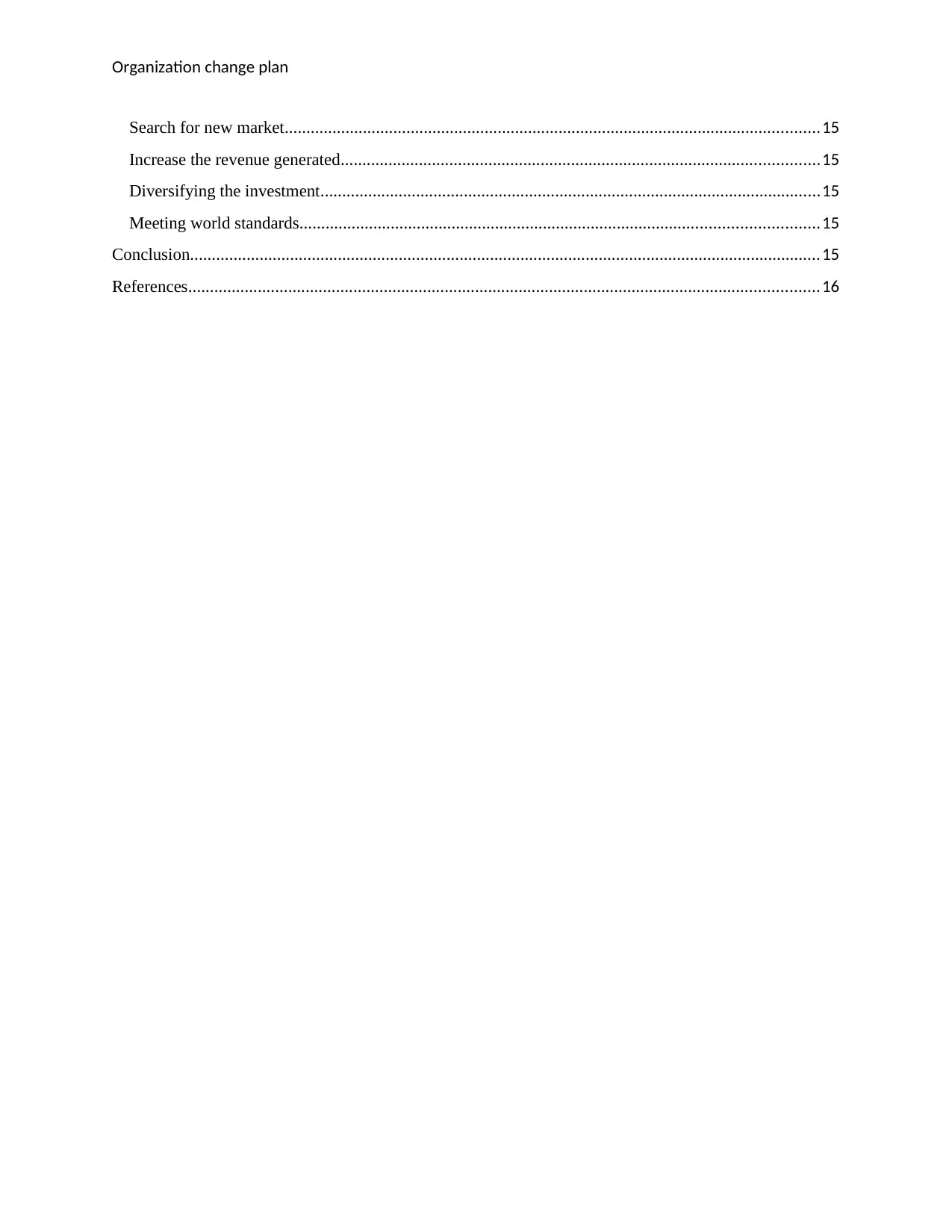
Organization change plan
Search for new market...........................................................................................................................15
Increase the revenue generated..............................................................................................................15
Diversifying the investment...................................................................................................................15
Meeting world standards.......................................................................................................................15
Conclusion.................................................................................................................................................15
References.................................................................................................................................................16
Search for new market...........................................................................................................................15
Increase the revenue generated..............................................................................................................15
Diversifying the investment...................................................................................................................15
Meeting world standards.......................................................................................................................15
Conclusion.................................................................................................................................................15
References.................................................................................................................................................16
Paraphrase This Document
Need a fresh take? Get an instant paraphrase of this document with our AI Paraphraser
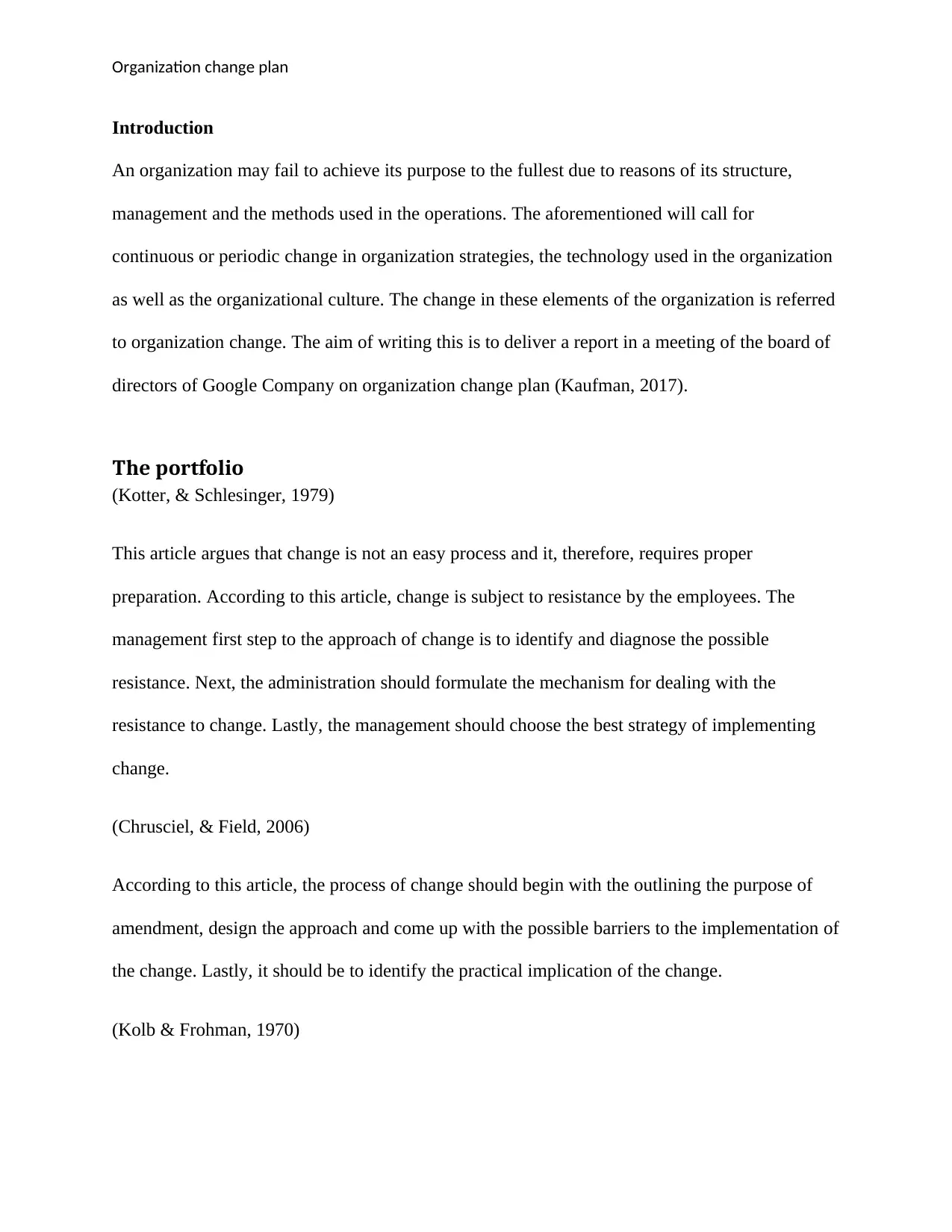
Organization change plan
Introduction
An organization may fail to achieve its purpose to the fullest due to reasons of its structure,
management and the methods used in the operations. The aforementioned will call for
continuous or periodic change in organization strategies, the technology used in the organization
as well as the organizational culture. The change in these elements of the organization is referred
to organization change. The aim of writing this is to deliver a report in a meeting of the board of
directors of Google Company on organization change plan (Kaufman, 2017).
The portfolio
(Kotter, & Schlesinger, 1979)
This article argues that change is not an easy process and it, therefore, requires proper
preparation. According to this article, change is subject to resistance by the employees. The
management first step to the approach of change is to identify and diagnose the possible
resistance. Next, the administration should formulate the mechanism for dealing with the
resistance to change. Lastly, the management should choose the best strategy of implementing
change.
(Chrusciel, & Field, 2006)
According to this article, the process of change should begin with the outlining the purpose of
amendment, design the approach and come up with the possible barriers to the implementation of
the change. Lastly, it should be to identify the practical implication of the change.
(Kolb & Frohman, 1970)
Introduction
An organization may fail to achieve its purpose to the fullest due to reasons of its structure,
management and the methods used in the operations. The aforementioned will call for
continuous or periodic change in organization strategies, the technology used in the organization
as well as the organizational culture. The change in these elements of the organization is referred
to organization change. The aim of writing this is to deliver a report in a meeting of the board of
directors of Google Company on organization change plan (Kaufman, 2017).
The portfolio
(Kotter, & Schlesinger, 1979)
This article argues that change is not an easy process and it, therefore, requires proper
preparation. According to this article, change is subject to resistance by the employees. The
management first step to the approach of change is to identify and diagnose the possible
resistance. Next, the administration should formulate the mechanism for dealing with the
resistance to change. Lastly, the management should choose the best strategy of implementing
change.
(Chrusciel, & Field, 2006)
According to this article, the process of change should begin with the outlining the purpose of
amendment, design the approach and come up with the possible barriers to the implementation of
the change. Lastly, it should be to identify the practical implication of the change.
(Kolb & Frohman, 1970)
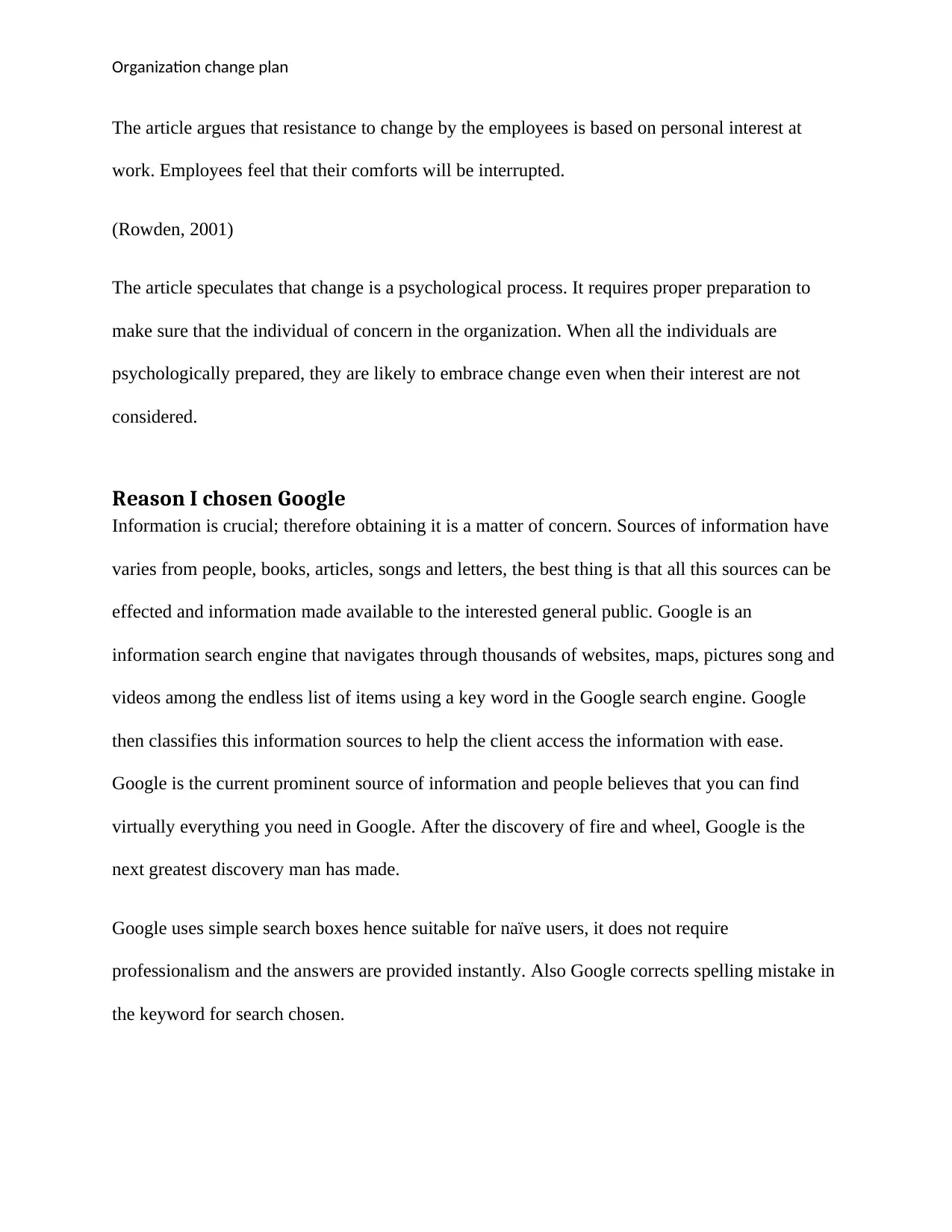
Organization change plan
The article argues that resistance to change by the employees is based on personal interest at
work. Employees feel that their comforts will be interrupted.
(Rowden, 2001)
The article speculates that change is a psychological process. It requires proper preparation to
make sure that the individual of concern in the organization. When all the individuals are
psychologically prepared, they are likely to embrace change even when their interest are not
considered.
Reason I chosen Google
Information is crucial; therefore obtaining it is a matter of concern. Sources of information have
varies from people, books, articles, songs and letters, the best thing is that all this sources can be
effected and information made available to the interested general public. Google is an
information search engine that navigates through thousands of websites, maps, pictures song and
videos among the endless list of items using a key word in the Google search engine. Google
then classifies this information sources to help the client access the information with ease.
Google is the current prominent source of information and people believes that you can find
virtually everything you need in Google. After the discovery of fire and wheel, Google is the
next greatest discovery man has made.
Google uses simple search boxes hence suitable for naïve users, it does not require
professionalism and the answers are provided instantly. Also Google corrects spelling mistake in
the keyword for search chosen.
The article argues that resistance to change by the employees is based on personal interest at
work. Employees feel that their comforts will be interrupted.
(Rowden, 2001)
The article speculates that change is a psychological process. It requires proper preparation to
make sure that the individual of concern in the organization. When all the individuals are
psychologically prepared, they are likely to embrace change even when their interest are not
considered.
Reason I chosen Google
Information is crucial; therefore obtaining it is a matter of concern. Sources of information have
varies from people, books, articles, songs and letters, the best thing is that all this sources can be
effected and information made available to the interested general public. Google is an
information search engine that navigates through thousands of websites, maps, pictures song and
videos among the endless list of items using a key word in the Google search engine. Google
then classifies this information sources to help the client access the information with ease.
Google is the current prominent source of information and people believes that you can find
virtually everything you need in Google. After the discovery of fire and wheel, Google is the
next greatest discovery man has made.
Google uses simple search boxes hence suitable for naïve users, it does not require
professionalism and the answers are provided instantly. Also Google corrects spelling mistake in
the keyword for search chosen.
⊘ This is a preview!⊘
Do you want full access?
Subscribe today to unlock all pages.

Trusted by 1+ million students worldwide

Organization change plan
Business wise, Google has a heavy commercial advertisement platform and accounting on its
reliability as a source of information, it therefore has the potential to get its way out in a high
rate.
Considering all the above factors, its worth to discuss Google under the theme organization
change, the discussion will cut through the management and the employees and provide desirable
or recommended changes.
Objectives of the organization change plan
The objectives of the organization change plan in Google Company are to create an
environmental sustainability plan. These will be achieved through by increase in the efficiency
and motivation of employees. It will also help in proper resources allocation thus maximizing
their utilization. The change plan will also help the Google Company reach its desired future
through proper maintenance of its day to day operations. The plan will also address the means
and the importance of considering the concerns of the employees and clients through
consideration of how information is presented to Google users. A change plan is also a reliable
tool that will help the organization on reducing the number and the impact of occurrence of a risk
in the organization. The change plan will also play a significant role in boosting the morale of the
stakeholders, employees and the suppliers of the Google Company (Petrou, Demerouti, &
Schaufeli, 2018).
Business wise, Google has a heavy commercial advertisement platform and accounting on its
reliability as a source of information, it therefore has the potential to get its way out in a high
rate.
Considering all the above factors, its worth to discuss Google under the theme organization
change, the discussion will cut through the management and the employees and provide desirable
or recommended changes.
Objectives of the organization change plan
The objectives of the organization change plan in Google Company are to create an
environmental sustainability plan. These will be achieved through by increase in the efficiency
and motivation of employees. It will also help in proper resources allocation thus maximizing
their utilization. The change plan will also help the Google Company reach its desired future
through proper maintenance of its day to day operations. The plan will also address the means
and the importance of considering the concerns of the employees and clients through
consideration of how information is presented to Google users. A change plan is also a reliable
tool that will help the organization on reducing the number and the impact of occurrence of a risk
in the organization. The change plan will also play a significant role in boosting the morale of the
stakeholders, employees and the suppliers of the Google Company (Petrou, Demerouti, &
Schaufeli, 2018).
Paraphrase This Document
Need a fresh take? Get an instant paraphrase of this document with our AI Paraphraser

Organization change plan
Role of the strategic renewal in propelling change
With the current growth rate of technology, it is entirely unhealthy business wise to think that
your business can continue selling the same old products to the same old customers, I the same
old price under the same old services, and counter your competitors. It is advisable for the
business to stop selling what it has and instead sell what the customers need.
Business organizations should always struggle to meet the changing needs of their customers.
This is accomplished by giving the following key factors, significant consideration. First, the
organization needs to identify and well define its customers or the people who it serves.
Secondly, the organization should consider what it provides; in this note; the organization should
strive to provide what the customers need rather than just providing services simply because you
have them. The organization should also put a lot of stress in the evaluation of how it serves its
customers. How you serve your customers have a significant impact on determining whether
they will have an urge to come for the same services later and or even with their friend (Yousef,
2017). The business aims to make a profit, the organization should have a clear definition of how
it makes money. This will enable the organization to avoid unnecessary losses or customers
exploitation. Finally, the organization should identify, differentiate and sustain the advantages it
has over the other competing firms.
With all the above, the organization will be in a good position to:
Challenge the notion they have on who their customers are, and therefore will be able to
determine how they or should interact with them. This will also enable them to determine how
they brand and define their products and configure the value chain.
Role of the strategic renewal in propelling change
With the current growth rate of technology, it is entirely unhealthy business wise to think that
your business can continue selling the same old products to the same old customers, I the same
old price under the same old services, and counter your competitors. It is advisable for the
business to stop selling what it has and instead sell what the customers need.
Business organizations should always struggle to meet the changing needs of their customers.
This is accomplished by giving the following key factors, significant consideration. First, the
organization needs to identify and well define its customers or the people who it serves.
Secondly, the organization should consider what it provides; in this note; the organization should
strive to provide what the customers need rather than just providing services simply because you
have them. The organization should also put a lot of stress in the evaluation of how it serves its
customers. How you serve your customers have a significant impact on determining whether
they will have an urge to come for the same services later and or even with their friend (Yousef,
2017). The business aims to make a profit, the organization should have a clear definition of how
it makes money. This will enable the organization to avoid unnecessary losses or customers
exploitation. Finally, the organization should identify, differentiate and sustain the advantages it
has over the other competing firms.
With all the above, the organization will be in a good position to:
Challenge the notion they have on who their customers are, and therefore will be able to
determine how they or should interact with them. This will also enable them to determine how
they brand and define their products and configure the value chain.
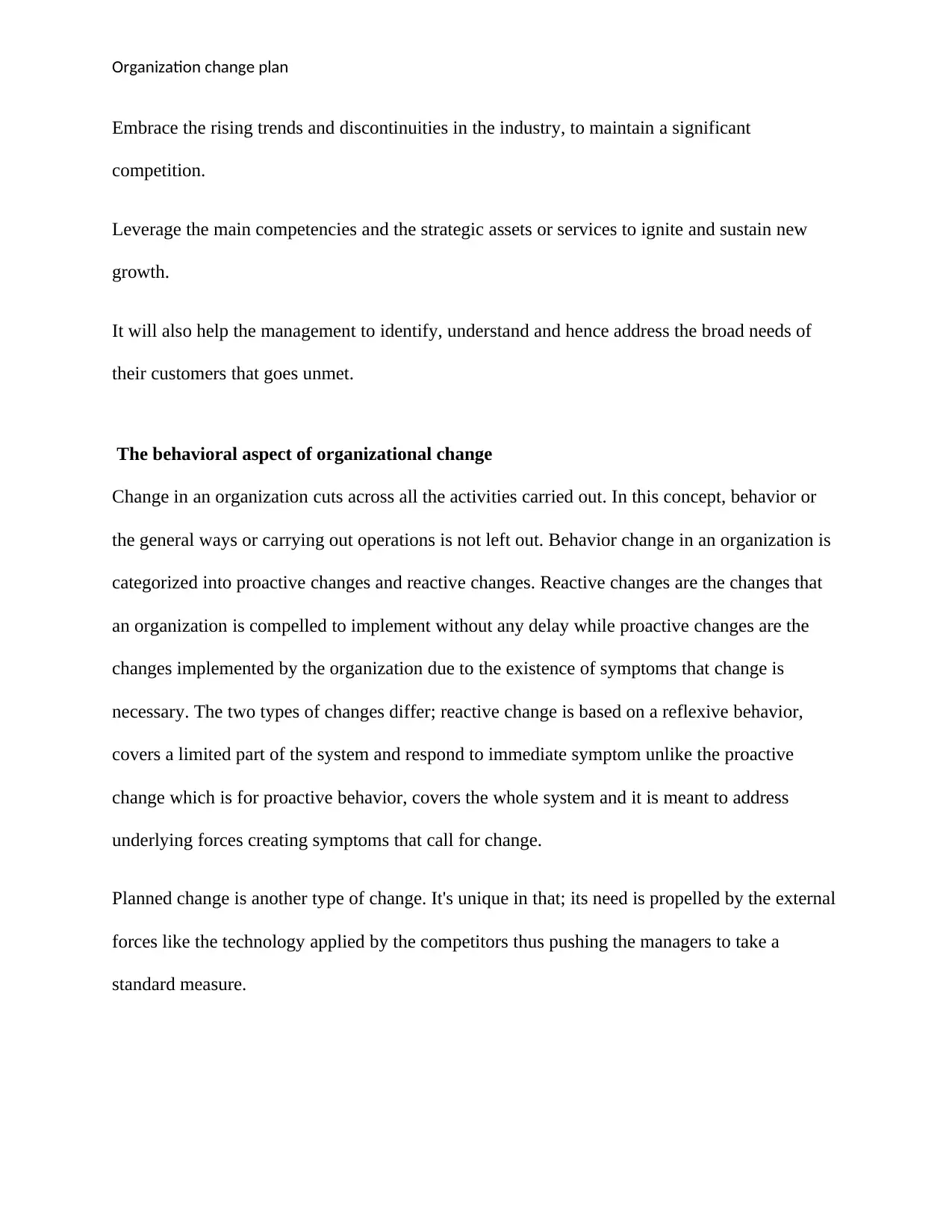
Organization change plan
Embrace the rising trends and discontinuities in the industry, to maintain a significant
competition.
Leverage the main competencies and the strategic assets or services to ignite and sustain new
growth.
It will also help the management to identify, understand and hence address the broad needs of
their customers that goes unmet.
The behavioral aspect of organizational change
Change in an organization cuts across all the activities carried out. In this concept, behavior or
the general ways or carrying out operations is not left out. Behavior change in an organization is
categorized into proactive changes and reactive changes. Reactive changes are the changes that
an organization is compelled to implement without any delay while proactive changes are the
changes implemented by the organization due to the existence of symptoms that change is
necessary. The two types of changes differ; reactive change is based on a reflexive behavior,
covers a limited part of the system and respond to immediate symptom unlike the proactive
change which is for proactive behavior, covers the whole system and it is meant to address
underlying forces creating symptoms that call for change.
Planned change is another type of change. It's unique in that; its need is propelled by the external
forces like the technology applied by the competitors thus pushing the managers to take a
standard measure.
Embrace the rising trends and discontinuities in the industry, to maintain a significant
competition.
Leverage the main competencies and the strategic assets or services to ignite and sustain new
growth.
It will also help the management to identify, understand and hence address the broad needs of
their customers that goes unmet.
The behavioral aspect of organizational change
Change in an organization cuts across all the activities carried out. In this concept, behavior or
the general ways or carrying out operations is not left out. Behavior change in an organization is
categorized into proactive changes and reactive changes. Reactive changes are the changes that
an organization is compelled to implement without any delay while proactive changes are the
changes implemented by the organization due to the existence of symptoms that change is
necessary. The two types of changes differ; reactive change is based on a reflexive behavior,
covers a limited part of the system and respond to immediate symptom unlike the proactive
change which is for proactive behavior, covers the whole system and it is meant to address
underlying forces creating symptoms that call for change.
Planned change is another type of change. It's unique in that; its need is propelled by the external
forces like the technology applied by the competitors thus pushing the managers to take a
standard measure.
⊘ This is a preview!⊘
Do you want full access?
Subscribe today to unlock all pages.

Trusted by 1+ million students worldwide

Organization change plan
Causes of organization's behavioral change
The change in technology cannot be ignored by any organization that has to remain relevant in
the industry. This is because; new technology results in the development of a new tool, machine,
and equipment which are more efficient than the existing ones. For instance, automatic machines
will result in replacement and displacement of staffs to regain equilibrium.
Different managerial persona has different skills and thus differs in their way of management.
Therefore, when the management is changed either through replacement of the retired managers
or new appointment, the policies, practices, and procedures of the organization are changed to
some extent.
The government may set rules and regulations that will call for change in the organization; the
change is inevitable basing on the fact that all organizations must comply with the rules of
governance.
The organization must also recall the rule the survival for the fittest. Accounting on this, the
organization must come up with the challenges posed by its competitors to counter the
competition and sustain their survival.
Customer needs may change, either because of change in the amount of earning or any other
reason. For instance, if people's income increases, there is a possibility that they will need more
luxurious things like five-star hotel yet they were contented by the services they received from a
two-star hotel.
Causes of organization's behavioral change
The change in technology cannot be ignored by any organization that has to remain relevant in
the industry. This is because; new technology results in the development of a new tool, machine,
and equipment which are more efficient than the existing ones. For instance, automatic machines
will result in replacement and displacement of staffs to regain equilibrium.
Different managerial persona has different skills and thus differs in their way of management.
Therefore, when the management is changed either through replacement of the retired managers
or new appointment, the policies, practices, and procedures of the organization are changed to
some extent.
The government may set rules and regulations that will call for change in the organization; the
change is inevitable basing on the fact that all organizations must comply with the rules of
governance.
The organization must also recall the rule the survival for the fittest. Accounting on this, the
organization must come up with the challenges posed by its competitors to counter the
competition and sustain their survival.
Customer needs may change, either because of change in the amount of earning or any other
reason. For instance, if people's income increases, there is a possibility that they will need more
luxurious things like five-star hotel yet they were contented by the services they received from a
two-star hotel.
Paraphrase This Document
Need a fresh take? Get an instant paraphrase of this document with our AI Paraphraser
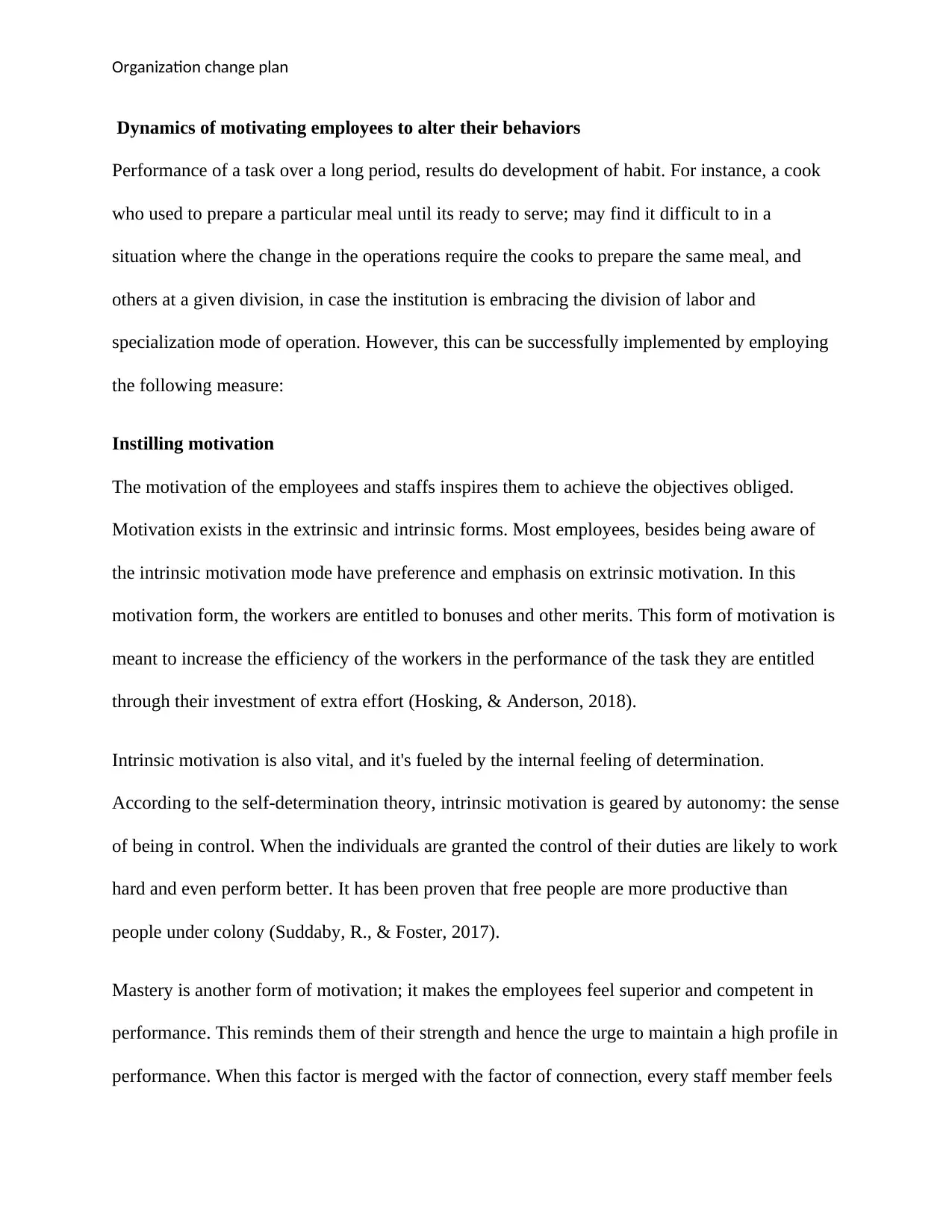
Organization change plan
Dynamics of motivating employees to alter their behaviors
Performance of a task over a long period, results do development of habit. For instance, a cook
who used to prepare a particular meal until its ready to serve; may find it difficult to in a
situation where the change in the operations require the cooks to prepare the same meal, and
others at a given division, in case the institution is embracing the division of labor and
specialization mode of operation. However, this can be successfully implemented by employing
the following measure:
Instilling motivation
The motivation of the employees and staffs inspires them to achieve the objectives obliged.
Motivation exists in the extrinsic and intrinsic forms. Most employees, besides being aware of
the intrinsic motivation mode have preference and emphasis on extrinsic motivation. In this
motivation form, the workers are entitled to bonuses and other merits. This form of motivation is
meant to increase the efficiency of the workers in the performance of the task they are entitled
through their investment of extra effort (Hosking, & Anderson, 2018).
Intrinsic motivation is also vital, and it's fueled by the internal feeling of determination.
According to the self-determination theory, intrinsic motivation is geared by autonomy: the sense
of being in control. When the individuals are granted the control of their duties are likely to work
hard and even perform better. It has been proven that free people are more productive than
people under colony (Suddaby, R., & Foster, 2017).
Mastery is another form of motivation; it makes the employees feel superior and competent in
performance. This reminds them of their strength and hence the urge to maintain a high profile in
performance. When this factor is merged with the factor of connection, every staff member feels
Dynamics of motivating employees to alter their behaviors
Performance of a task over a long period, results do development of habit. For instance, a cook
who used to prepare a particular meal until its ready to serve; may find it difficult to in a
situation where the change in the operations require the cooks to prepare the same meal, and
others at a given division, in case the institution is embracing the division of labor and
specialization mode of operation. However, this can be successfully implemented by employing
the following measure:
Instilling motivation
The motivation of the employees and staffs inspires them to achieve the objectives obliged.
Motivation exists in the extrinsic and intrinsic forms. Most employees, besides being aware of
the intrinsic motivation mode have preference and emphasis on extrinsic motivation. In this
motivation form, the workers are entitled to bonuses and other merits. This form of motivation is
meant to increase the efficiency of the workers in the performance of the task they are entitled
through their investment of extra effort (Hosking, & Anderson, 2018).
Intrinsic motivation is also vital, and it's fueled by the internal feeling of determination.
According to the self-determination theory, intrinsic motivation is geared by autonomy: the sense
of being in control. When the individuals are granted the control of their duties are likely to work
hard and even perform better. It has been proven that free people are more productive than
people under colony (Suddaby, R., & Foster, 2017).
Mastery is another form of motivation; it makes the employees feel superior and competent in
performance. This reminds them of their strength and hence the urge to maintain a high profile in
performance. When this factor is merged with the factor of connection, every staff member feels

Organization change plan
to count and has a purpose. This creates a high level of dedication to achieve the objectives of
the organization (Neves, & Schyns, 2018).
Developing psychological capital
This refers to the individual's self-beliefs and will-power. The psychological capital has a
significant effect on the organizations' outcome such as absenteeism, work performance, and
performance. This factor is implemented through the initiation of staff's self-confidence,
resilience, optimism and will power (Cameron, & Green, 2015).
Building a supportive environment for change
To empower and maintain the change in the organization, it is advisable to create a supportive
environment. This is achieved through three elements: social support, habit structure and choice
architecture (Sindhu, Ahmad, & Hashmi, 2017)
Faces of organizational change
Organizational change is divided into three faces: the Turnaround face, the Tool of techniques
and the Transformation target.
Turnaround
This face focuses on how better the internal resources of the organization should be managed.
An organization may cut or add resources depending on how better this is to the company. For
instance, the organization may cut cash in the organization to manage cash flow or add more
cash to purchase an asset that is thought or believed to increase the efficiency of the organization
(Lord, Dinh, & Hoffman, 2015).
to count and has a purpose. This creates a high level of dedication to achieve the objectives of
the organization (Neves, & Schyns, 2018).
Developing psychological capital
This refers to the individual's self-beliefs and will-power. The psychological capital has a
significant effect on the organizations' outcome such as absenteeism, work performance, and
performance. This factor is implemented through the initiation of staff's self-confidence,
resilience, optimism and will power (Cameron, & Green, 2015).
Building a supportive environment for change
To empower and maintain the change in the organization, it is advisable to create a supportive
environment. This is achieved through three elements: social support, habit structure and choice
architecture (Sindhu, Ahmad, & Hashmi, 2017)
Faces of organizational change
Organizational change is divided into three faces: the Turnaround face, the Tool of techniques
and the Transformation target.
Turnaround
This face focuses on how better the internal resources of the organization should be managed.
An organization may cut or add resources depending on how better this is to the company. For
instance, the organization may cut cash in the organization to manage cash flow or add more
cash to purchase an asset that is thought or believed to increase the efficiency of the organization
(Lord, Dinh, & Hoffman, 2015).
⊘ This is a preview!⊘
Do you want full access?
Subscribe today to unlock all pages.

Trusted by 1+ million students worldwide
1 out of 19
Related Documents
Your All-in-One AI-Powered Toolkit for Academic Success.
+13062052269
info@desklib.com
Available 24*7 on WhatsApp / Email
![[object Object]](/_next/static/media/star-bottom.7253800d.svg)
Unlock your academic potential
Copyright © 2020–2025 A2Z Services. All Rights Reserved. Developed and managed by ZUCOL.





